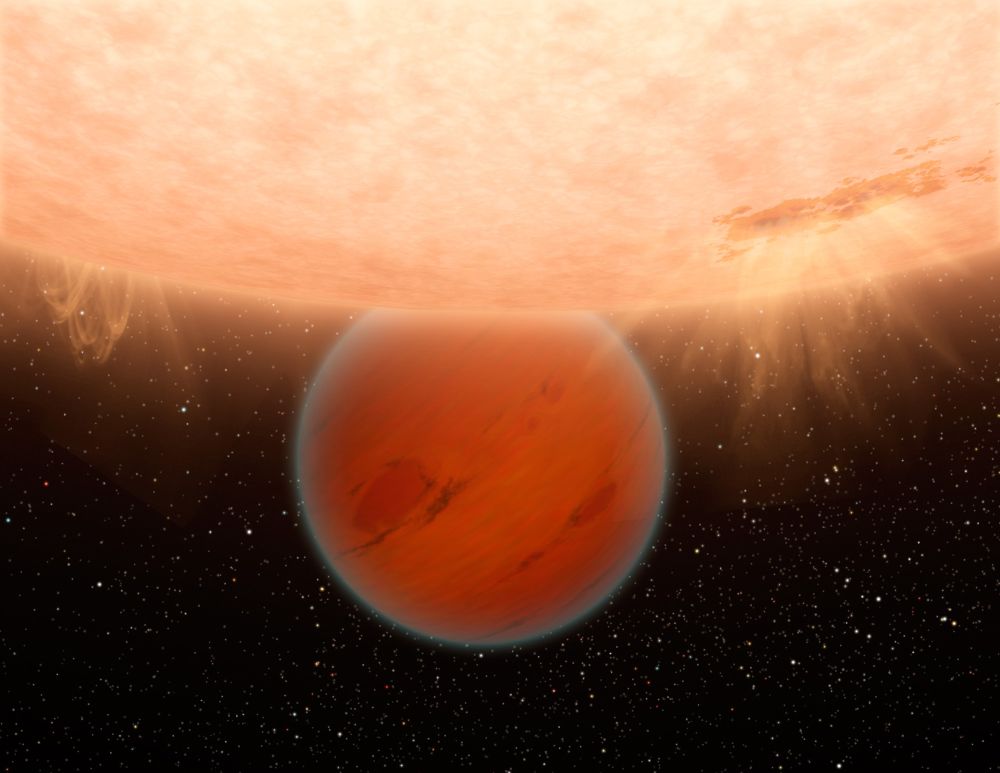An Earth-like exoplanet in mass and size discovered
October 31, 2013

Artist’s rendition of an exoplanet Gliese 436b (credit: NASA/JPL-Caltech)
By analyzing the movement of its host star, Kepler 78, the scientists determined that the exoplanet is about 1.7 times as massive as the Earth.
From the same measurements, they calculated that the planet’s density is 5.3 grams per cubic centimeter, closely resembling Earth’s density (5.5 grams per cubic centimeter).
The findings make Kepler 78b the smallest exoplanet for which the mass and size are known. These new measurements provide strong evidence that Kepler 78b is composed mostly of rock and iron, similar to Earth.
However, that’s where the similarities may end: the exoplanet, due to its extreme proximity to its star, is likely blazing at temperatures too high to support life — “at least 2,000 degrees hotter,” says team member Josh Winn, an associate professor of physics at MIT and a member of the Kavli Institute for Astrophysics and Space Research.
Watching for a wobble
Planets with extremely tight orbits offer scientists a wealth of data: For instance, each week Kepler 78b circles its star about 20 times, giving researchers numerous opportunities to observe its behavior.
The team previously determined Kepler 78b’s orbit and size by analyzing the light given off by the star as the planet passes in front of it, or transits. The researchers detected a transit each time the star’s light dipped, and measured this dimming to determine the planet’s size. (The bigger an exoplanet, the more light it blocks.)
Measuring the planet’s mass was a somewhat trickier endeavor. Instead of tracking the planet’s motion, the researchers tracked the motion of the star itself. Depending on its mass, a planet can exert a gravitational tug on its star. This stellar motion can be detected as a very slight wobble, known as a Doppler shift.
Winn and his colleagues looked to measure Kepler 78’s Doppler shift by analyzing observations from the Keck Observatory in Hawaii — one of the largest telescopes in the world. The team analyzed starlight data taken over a period of eight days. Despite the telescope’s strength, the signal from the star was incredibly faint, making a daunting task for the scientists.
Co-authors on the paper include researchers from the University of Hawaii, the University of California at Berkeley, the Harvard-Smithsonian Center for Astrophysics, the University of California at Santa Cruz, and Yale University.
This research received support from NASA and the Kepler Participating Scientist Program.
Abstract of Nature paper
Planets with sizes between that of Earth (with radius R) and Neptune (about 4 R) are now known to be common around Sun-like stars. Most such planets have been discovered through the transit technique, by which the planet’s size can be determined from the fraction of starlight blocked by the planet as it passes in front of its star. Measuring the planet’s mass — and hence its density, which is a clue to its composition — is more difficult. Planets of size 2–4 R have proved to have a wide range of densities, implying a diversity of compositions, but these measurements did not extend to planets as small as Earth. Here we report Doppler spectroscopic measurements of the mass of the Earth-sized planet Kepler-78b, which orbits its host star every 8.5 hours. Given a radius of 1.20 ± 0.09 R and a mass of 1.69 ± 0.41 M, the planet’s mean density of 5.3 ± 1.8 g cm−3 is similar to Earth’s, suggesting a composition of rock and iron.
(¯`*• Global Source and/or more resources at http://goo.gl/zvSV7 │ www.Future-Observatory.blogspot.com and on LinkeIn Group's "Becoming Aware of the Futures" at http://goo.gl/8qKBbK │ @SciCzar │ Point of Contact: www.linkedin.com/in/AndresAgostini
 Washington
Washington